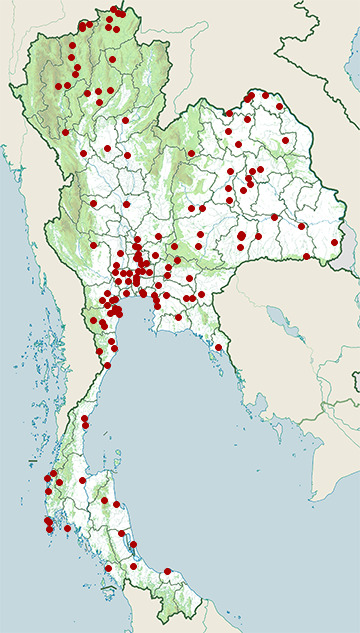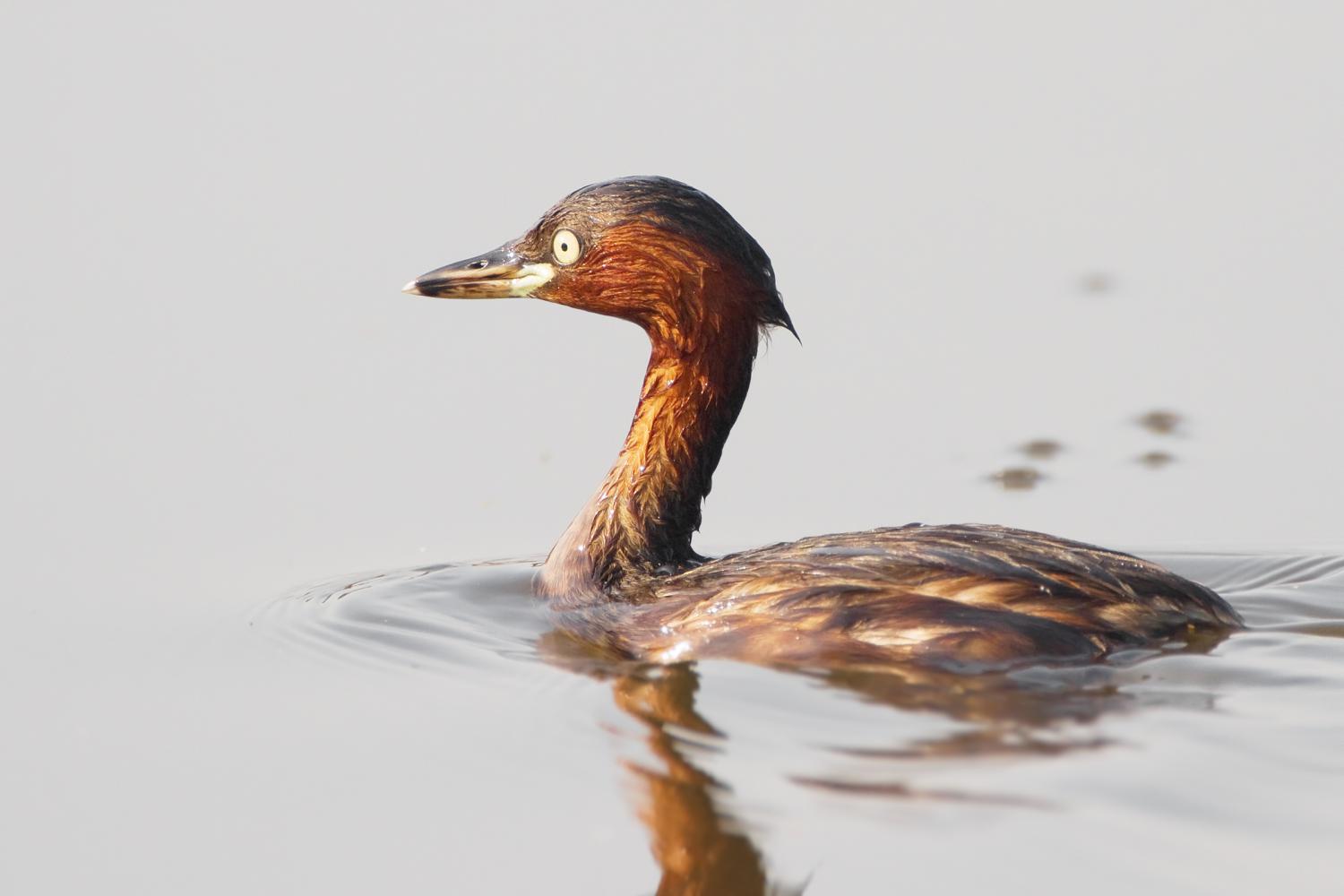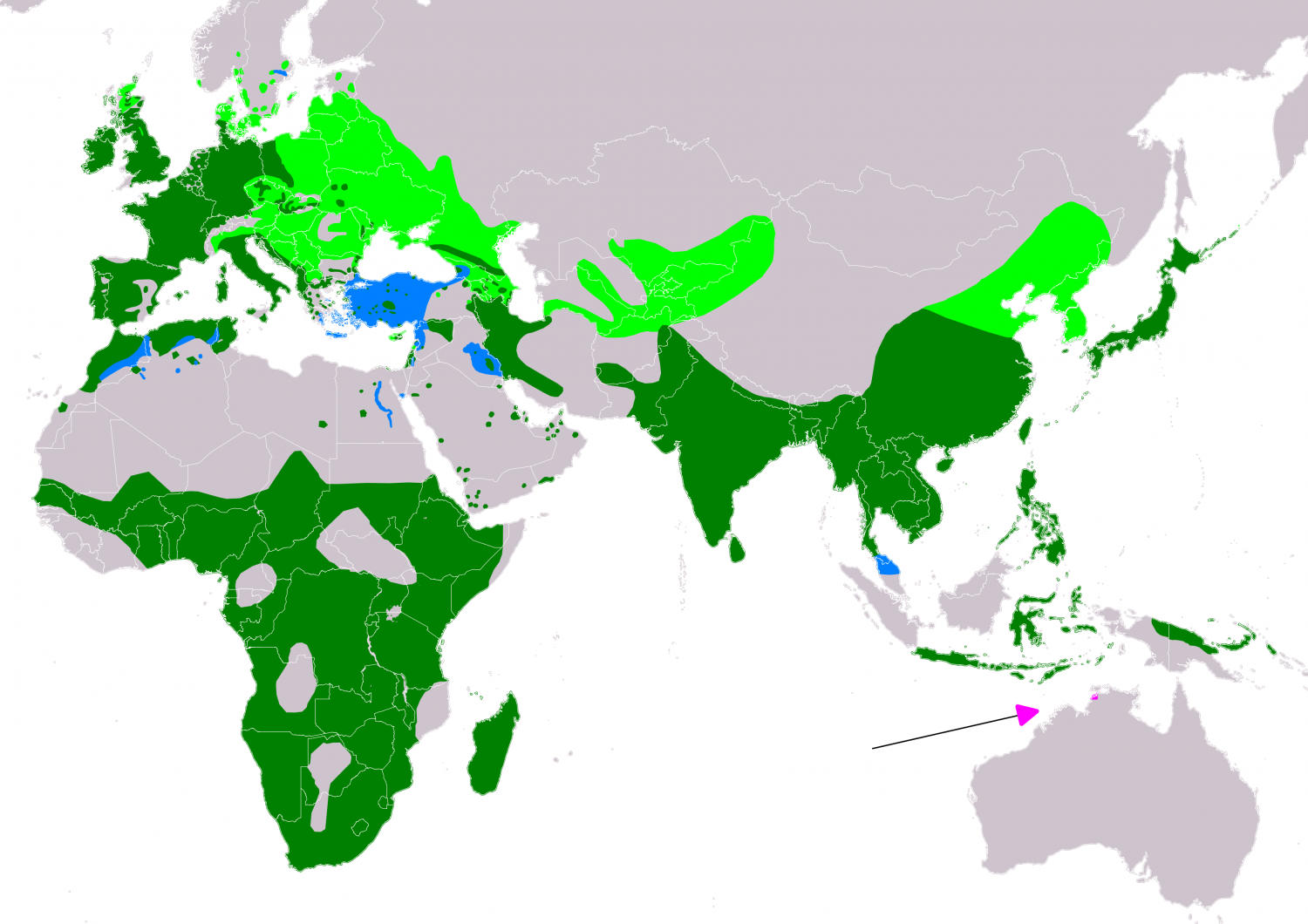Species of Thailand
Little grebe
Tachybaptus ruficollis
Peter Simon Pallas, 1764
In Thai: นกเป็ดผีเล็ก
The little grebe (Tachybaptus ruficollis), also known as dabchick, is a member of the grebe family of water birds. The genus name is from Ancient Greek takhus "fast" and bapto "to sink under". The specific ruficollis is from Latin rufus "red" and Modern Latin -collis, "-necked", itself derived from Latin collum "neck".
At 23 to 29 cm in length it is the smallest European member of its family. It is commonly found in open bodies of water across most of its range.
Taxonomy
The little grebe was described by the German naturalist Peter Simon Pallas in 1764 and given the binomial name Colymbus ruficollis. The tricolored grebe was considered conpecific, with some taxonomic authorities still considering it so.
There are six currently-recognized subspecies, separated principally by size and colouration.
- T. r. ruficollis – (Pallas, 1764): nominate, found from Europe and western Russia south to North Africa
- T. r. iraquensis – (Ticehurst, 1923): found in southeastern Iraq and southwestern Iran
- T. r. capensis – (Salvadori, 1884): found in Sub-Saharan Africa, Madagascar, Sri Lanka, and the Indian subcontinent, extending east to Burma
- T. r. poggei – (Reichenow, 1902): found from southeastern to northeastern Asia, Hainan, Taiwan, Japan, and south Kuril Islands
- T. r. philippensis – (Bonnaterre, 1790): found in the northern Philippines
- T. r. cotabato – (Rand, 1948): found on Mindanao
Description
The little grebe is a small water bird with a pointed bill. The adult is unmistakable in summer, predominantly dark above with its rich, rufous colour neck, cheeks and flanks, and bright yellow gape. The rufous is replaced by a dirty brownish grey in non-breeding and juvenile birds.
Juvenile birds have a yellow bill with a small black tip, and black and white streaks on the cheeks and sides of the neck as seen below. This yellow bill darkens as the juveniles age, eventually turning black in adulthood.
In winter, its size, buff plumage, with a darker back and cap, and “powder puff” rear end enable easy identification of this species. The little grebe's breeding call, given singly or in duet, is a trilled repeated weet-weet-weet or wee-wee-wee which sounds like a horse whinnying.
Distribution
This bird breeds in small colonies in heavily vegetated areas of freshwater lakes across Europe, much of Asia down to New Guinea, and most of Africa. Most birds move to more open or coastal waters in winter, but it is only migratory in those parts of its range where the waters freeze. Outside of breeding season, it moves into more open water, occasionally even appearing on the coast in small bays.
Behaviour
The little grebe is an excellent swimmer and diver and pursues its fish and aquatic invertebrate prey underwater. It uses the vegetation skilfully as a hiding place.
Like all grebes, it nests at the water's edge, since its legs are set very far back and it cannot walk well. Usually four to seven eggs are laid. When the adult bird leaves the nest it usually takes care to cover the eggs with weeds. This makes it less likely to be detected by predators. The young leave the nest and can swim soon after hatching, and chicks are often carried on the backs of the swimming adults. In India, the species breeds during the rainy season.
This article uses material from Wikipedia released under the Creative Commons Attribution-Share-Alike Licence 3.0. Eventual photos shown in this page may or may not be from Wikipedia, please see the license details for photos in photo by-lines.
Category / Seasonal Status
BCST Category: Recorded in an apparently wild state within the last 50 years
BCST Seasonal statuses:
- Resident or presumed resident
- Possibly non-breeding visitor
Scientific classification
- Kingdom
- Animalia
- Phylum
- Chordata
- Class
- Aves
- Order
- Podicipediformes
- Family
- Podicipedidae
- Genus
- Tachybaptus
- Species
- Tachybaptus ruficollis
Common names
- English: Little grebe
- French: Grèbe castagneux
- Thai: นกเป็ดผีเล็ก
Subspecies
Tachybaptus ruficollis capensis, Tommaso Salvadori, 1884
Range: Sub-Saharan Africa, Madagascar, Sri Lanka, and the Indian subcontinent, extending east to Burma
Tachybaptus ruficollis cotabato, Rand, 1948
Range: Mindanao
Tachybaptus ruficollis iraquensis, Claud Buchanan Ticehurst, 1923
Range: Found in southeastern Iraq and southwestern Iran
Tachybaptus ruficollis philippensis, Bonnaterre, 1790
Range: Northern Philippines
Tachybaptus ruficollis poggei, Anton Reichenow, 1902
Range: From southeastern to northeastern Asia, Hainan, Taiwan, Japan and south Kuril Islands
Tachybaptus ruficollis ruficollis, Peter Simon Pallas, 1764
Range: Found from Europe and western Russia south to North Africa
Synonyms
- Podiceps ruficollis
Conservation status

Least Concern (IUCN3.1)
Photos
Please help us review the bird photos if wrong ones are used. We can be reached via our contact us page.
Range Map

- Amphawa District, Samut Songkhram
- Ban Dung District, Udon Thani
- Ban Laem District, Phetchaburi
- Ban Lat District, Phetchaburi
- Ban Lueam District, Nakhon Ratchasima
- Ban Phai District, Khon Kaen
- Ban Phraek District, Phra Nakhon Si Ayutthaya
- Ban Sang District, Prachinburi
- Bang Ban District, Phra Nakhon Si Ayutthaya
- Bang Len District, Nakhon Pathom
- Bang Pa In District, Phra Nakhon Si Ayutthaya
- Bang Pahan District, Phra Nakhon Si Ayutthaya
- Bang Pakong District, Chachoengsao
- Bang Phra Non-Hunting Area
- Bang Pu Recreation Centre
- Bangkok Province
- Borabue District, Maha Sarakham
- Bueng Boraped Non-Hunting Area
- Bueng Boraphet Non-Hunting Area
- Bueng Khong Long Non-Hunting Area
- Buntharik District, Ubon Ratchathani
- Chaiyo District, Ang Thong
- Chatturat District, Chaiyaphum
- Chiang Dao District, Chiang Mai
- Chiang Saen District, Chiang Rai
- Doi Inthanon National Park
- Doi Lo District, Chiang Mai
- Doi Pha Hom Pok National Park
- Fang District, Chiang Mai
- Hang Chat District, Lampang
- Hat Yai District, Songkhla
- Huai Chorakhe Mak Reservoir Non-Hunting Area
- Huai Talat Reservoir Non-Hunting Area
- Kabin Buri District, Prachinburi
- Kaeng Krachan District, Phetchaburi
- Kaeng Krachan National Park
- Kamphaeng Saen District, Nakhon Pathom
- Kanthararom District, Sisaket
- Kantharawichai District, Maha Sarakham
- Khao Ang Rue Nai Wildlife Sanctuary
- Khao Kradong Forest Park
- Khao Luang National Park
- Khao Phra Wihan National Park
- Khao Sam Roi Yot National Park
- Khao Sok National Park
- Khao Yai National Park
- Khao Yoi District, Phetchaburi
- Khlong Luang District, Pathum Thani
- Khura Buri District, Phang Nga
- Ko Phra Thong
- Kui Buri National Park
- Kumphawapi District, Udon Thani
- Kut Thing Non-Hunting Area
- La-ngu District, Satun
- Laem Pak Bia
- Mae Ai District, Chiang Mai
- Mae Chan District, Chiang Rai
- Mae Mo District, Lampang
- Mae Poen District, Nakhon Sawan
- Mae Sai District, Chiang Rai
- Mae Taeng District, Chiang Mai
- Mae Tha, Lampang District, Lampang
- Mu Ko Chumphon National Park
- Mueang Buriram District, Buriram
- Mueang Chachoengsao District, Chachoengsao
- Mueang Chiang Mai District, Chiang Mai
- Mueang Chiang Rai District, Chiang Rai
- Mueang Chonburi District, Chonburi
- Mueang Kalasin District, Kalasin
- Mueang Khon Kaen District, Khon Kaen
- Mueang Lampang District, Lampang
- Mueang Maha Sarakham District, Maha Sarakham
- Mueang Nakhon Pathom District, Nakhon Pathom
- Mueang Nakhon Ratchasima District, Nakhon Ratchasima
- Mueang Nakhon Si Thammarat District, Nakhon Si Thammarat
- Mueang Nong Khai District, Nong Khai
- Mueang Nonthaburi District, Nonthaburi
- Mueang Pattani District, Pattani
- Mueang Phayao District, Phayao
- Mueang Phetchaburi District, Phetchaburi
- Mueang Phitsanulok District, Phitsanulok
- Mueang Phuket District, Phuket
- Mueang Prachuap Khiri Khan District, Prachuap Khiri Khan
- Mueang Ratchaburi District, Ratchaburi
- Mueang Samut Prakan District, Samut Prakan
- Mueang Samut Sakhon District, Samut Sakhon
- Mueang Samut Songkhram District, Samut Songkhram
- Mueang Sukhothai District, Sukhothai
- Mueang Suphanburi District, Suphan Buri
- Mueang Surin District, Surin
- Mueang Tak District, Tak
- Mueang Trat District, Trat
- Mueang Udon Thani District, Udon Thani
- Mueang Uttaradit District, Uttaradit
- Namtok Sam Lan National Park
- Nong Bong Khai Non-Hunting Area
- Nong Han Lake
- Nong Prue District, Kanchanaburi
- Nong Song Hong District, Khon Kaen
- Nong Yai Area Development Project Under Royal Init
- Pak Chong District, Nakhon Ratchasima
- Pak Khat District, Bueng Kan
- Pak Kret District, Nonthaburi
- Pak Phli District, Nakhon Nayok
- Pak Thale
- Pak Tho District, Ratchaburi
- Pak Thong Chai District, Nakhon Ratchasima
- Phanat Nikhom District, Chonburi
- Phatthana Nikhom District, Lopburi
- Phi Phi Islands
- Phra Nakhon Si Ayutthaya District, Phra Nakhon Si Ayutthaya
- Phu Kradueng District, Loei
- Phunphin District, Surat Thani
- Phutthamonthon District, Nakhon Pathom
- Pran Buri District, Prachuap Khiri Khan
- Rattanaburi District, Surin
- Rattanawapi District, Nong Khai
- Sai Noi District, Nonthaburi
- Sam Ngao District, Tak
- Samut Prakan Province
- San Sai District, Chiang Mai
- Sanam Bin Reservoir Non-Hunting Area
- Sathing Phra District, Songkhla
- Sirinat National Park
- Song Phi Nong District, Suphan Buri
- Takua Pa District, Phang Nga
- Tha Takiap District, Chachoengsao
- Tha Wung District, Lopburi
- Tha Yang District, Phetchaburi
- Thalang District, Phuket
- Thale Noi Non-Hunting Area
- Thanyaburi District, Pathum Thani
- Wang Chan District, Rayong
- Wang Nam Yen District, Sa Kaeo
- Wang Noi District, Phra Nakhon Si Ayutthaya
- Wat Phai Lom & Wat Ampu Wararam Non-Hunting Area
- Wiang Chai District, Chiang Rai
- Yang Talat District, Kalasin



